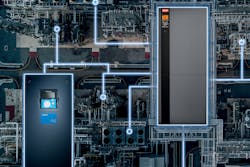Exploring the Quiet Side of Green Energy: Chat with Danfoss NA President Rick Sporrer
Energy efficiency and management of power in the commercial and industrial sectors is all about the understatement. Less is more, and that's the point.
To say the operator appreciates the growing role of variable speed and frequency technology on his or her plant’s pumps and motors is perhaps an understatement. Matching the drive to the load is simply making it all fit, right?
To say the plant or facilities manager values the long-term benefit of trimming energy use is also an understatement. Action in the form of lower bills and reduced emissions speaks louder than words.
But sometimes you just gotta speak truth to power.
“The greenest energy is the energy we don’t use,” Rick Sporrer, president of global facilities equipment manufacturer Danfoss’ North American unit, said in an interview with EnergyTech. “We believe that it can reduce 33 percent of current energy use if (industrial companies) just invested in the energy efficiency systems of today.”
Many companies are beginning to do just that, whether it’s Danfoss or a competitor’s offerings of pumps, drives and control technologies. Manufacturers such as Saint Gobain are upgrading their plants to reduce the carbon footprint, with the idea that energy efficiency is the “first fuel” in someday reaching net zero emissions goals.
The many paths to Net Zero include typical headline-grabbing EV fleet transitions, renewable energy power purchase agreements and microgrids. Sporrer acknowledges that the energy efficiency and building management innovations enabled by next-gen motor, drive, pump and control technologies are not the “sexy part of the energy transition,” but rather the ones which offer a way to see measurable returns on investment to curb energy costs and emissions.
“It’s differentiating, and they can see it in the data,” Sporrer says of customers embracing new equipment and sensors to both manage and predict energy use so they can decrease it without sacrificing performance and output.
“In some ways, for many years, some of that was overlooked,” by plant managers and other making ROI decisions on plant equipment. “They didn’t get a new frequency drive because of the costs upfront,” Sporrer added.
Building energy consumption and greenhouse gas emissions account for anywhere from 25 to 40 percent of estimated totals in those categories both in the U.S. and worldwide. Having an upfront, low-hanging fruit to plucking and trim both costs and pollution by one-third is becoming an easier, more immediate decision for manufacturing and industrial plant owners, with clients including power generation, desalination, petrochemical, manufacturing and real estate asset management.
Data center equipment designer Thermal Works recently worked with Danfoss on various fronts. The efforts included improving chiller technology to be air-cooled with zero water use, cutting energy by up to half with high evaporating temperature to achieve immediate efficiencies.
The key for OEMs and other equipment component suppliers is making the case with facility planners and managers. Getting them to calculate the life-cycle costs of the building, not just the upfront costs accrued with installing next-gen digital and equipment technologies, Sporrer noted.
“Because energy costs are going up, the things they were constrained on before is allowing them to consider some alternatives now,” he added. “How do I want the building to be five years from now?”
Improving cooling technology and electrification of plant operations—whether it be electric boilers or other types of alternatives to fossil-fired pieces—are key travelers on the Path to Net Zero. The power grid utilities are working to be ready for this wide-scale electrification, but trimming energy demand and emissions at the sources certainly helps with those challenges, he said.
A recent Danfoss white paper on the issue, “The Neglected Demand Side of the Green Equation,” highlighted the options now available. The advancements in motors, frequency drives, controls, sensors and other digital predictive tools is nothing short of amazing, kind of like a Moore’s Law for C&I building heating, cooling and production equipment.
But, wait, there’s more coming.
“I think we’re still just scratching the surface,” Danfoss’ Sporrer predicted. “The number of sensors continues to increase, and I think the same holds true for (improvements to) our cooling systems. The addition of electronic controls allows us to optimize performance points... and match demand and supply.”
And that’s simply making it all fit, right?
-- -- --
(Rod Walton, senior editor for EnergyTech, is a 14-year veteran of covering the energy industry both as a newspaper and trade journalist. He can be reached at [email protected]).
Follow us on Twitter @EnergyTechNews_ and @rodwaltonelp and on LinkedIn
About the Author
Rod Walton, EnergyTech Managing Editor
Managing Editor
For EnergyTech editorial inquiries, please contact Managing Editor Rod Walton at [email protected].
Rod Walton has spent 17 years covering the energy industry as a newspaper and trade journalist. He formerly was energy writer and business editor at the Tulsa World. Later, he spent six years covering the electricity power sector for Pennwell and Clarion Events. He joined Endeavor and EnergyTech in November 2021.
Walton earned his Bachelors degree in journalism from the University of Oklahoma. His career stops include the Moore American, Bartlesville Examiner-Enterprise, Wagoner Tribune and Tulsa World.
EnergyTech is focused on the mission critical and large-scale energy users and their sustainability and resiliency goals. These include the commercial and industrial sectors, as well as the military, universities, data centers and microgrids. The C&I sectors together account for close to 30 percent of greenhouse gas emissions in the U.S.
He was named Managing Editor for Microgrid Knowledge and EnergyTech starting July 1, 2023
Many large-scale energy users such as Fortune 500 companies, and mission-critical users such as military bases, universities, healthcare facilities, public safety and data centers, shifting their energy priorities to reach net-zero carbon goals within the coming decades. These include plans for renewable energy power purchase agreements, but also on-site resiliency projects such as microgrids, combined heat and power, rooftop solar, energy storage, digitalization and building efficiency upgrades.


